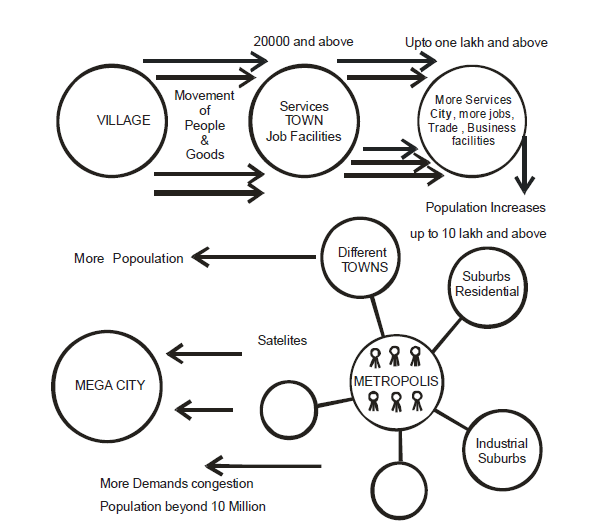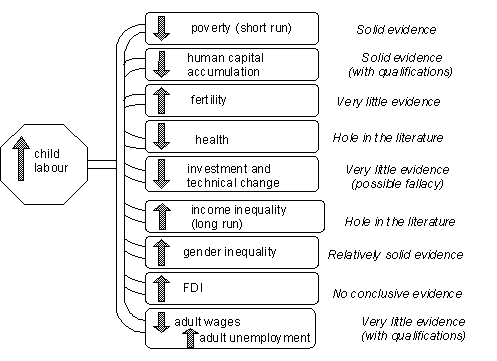Topics of interest for CSE:
- Evolution of modern industry in India.
- Growth of urban settlements in India.
- Working class: structure, growth, class mobilisation.
- Informal sector, child labour.
- Slums and deprivation in urban areas.
Urban Slum Population
UN Habitat: 58% of S. Asian urban population lives in slums compared to 43% for the rest of the developing countries and 31% for the world in general.MoHUA: 18% urban population lived in slums in 2011. Delhi NCR had as much as 42% residents in slums.
Child Labour
BBA: India has 10 million child labourers.
Informal sector
Labour Min: 80% of Indian workforce in the informal sector. Declining trend in recent years.
Growth of Urban Settlements in India
Census of India adopts the following criteria to define a city.
- Size of population – 5,000 or above
- Density – 1000/sq. mile and above
- Occupation – more than 75% of the inhabitants must be occupied in non- agricultural activities.
- Political administration – The urban area to be so classified must be governed by municipality.
- Pronounced urban characteristics – like market, water supply, road, electricity, transport and communication with standardized housing, banks, hospitals, courts and educational institutions.
Pitrim Sorokin and Zimmerman have given the following criteria for describing urban life:
- Heterogeneity of people
- Secondary relations - people form voluntary organisations on need basis and are indifferent to the existence of others.
- Social mobility
- Individual freedom
- Non-agricultural occupations
- Secondary control - the people are not controlled by family or religion but rather by secondary organisations like government, courts, police etc.
- Lack of community feeling
- Social disorganisation
- Unstable family
Louis Wirth has given a sociological definition of city “as a relatively large, dense and permanent settlement of socially heterogeneous individuals.” He further says that the people in a city adopt a different outlook to life which he dubs as
Urbanism.
Characteristics of urbanism:
- Growth and diversity are associated in the city with relatively weak bonds among co-residents.
- Problem of social integration is solved by physically separating the sub-groups to form homogeneous areas in the city.
- Social contacts in the city are impersonal, transitory and segmental. The aspects of personality which come in contact are only partial.
- City dwellers behave in a rational sophisticated manner and treat social relationships as means to an end.
- With increase DoL large firms tend to dominate the small family businesses. According to Wirth, the “corporation has no soul.”
- Extreme specialization and inter-dependence leads to an unstable equilibrium in the city.
- Increase in size of a city means greater reliance is placed on indirect communication as a method of spreading information and opinions and of making decisions. The mass-media and representatives of specific interests become important links in the communication between decision makers and the general public.
- As the density of population in an area increases it reinforces the effect of size in inducing greater specialization creating a feedback loop.
- Stratification is done only on the basis of material accumulation or growth.
- The city’s pattern of land use is the result of competition for a scarce resource.
- People with similar backgrounds and needs, therefore consciously or unwillingly drift or are forced by circumstances into the same selection of city. “Homogeneity” becomes the preferable factor.
- Co-residents engage in competition and mutual exploitation rather than co-operation due to superficial relations.
- Traffic signals and clock regulate city life as the density of people increases.
- Rate of crime increases.
- Absence of close and intimate relationship leads to increased rates of suicide among the individuals especially, those who are alone.
Critique: - Some of his deductions apply only to industrial cities if at all.
- Urban relations are not always secondary. City life is characterised by variety of relationships.
- Wirth has given due emphasis on secularization and disorganization in cities.
- But many studies showed that urbanization is not necessarily accompanied by destruction of social and moral order.
Manuel Castells is a Marxist Urban Sociologist. Network society is is a place where key social structures and activities are organised around electronically processed information networks.
Dr. Radhakamal Mukherjee notes the following patterns in urbanism:
- Ecologically, urbanism has a demographic, occupational and mechanical - technological base. People concentrate thickly on a particular place of specialization with various occupations.
- Biologically, the sex ratio is disturbed and imbalanced. Mostly men migrate from villages, women are less in cities. Leads to problems like prostitution, rape, sexual harassment etc.
- Sociologically, relations are secondary. Most of the relations are impersonal, contractual, formal and deliberate. People are more mobile and change their status very fast.
- Psychologically, money and status symbols dominate attitudes and behavior of urban people.

Noice thangs:
- Decline in ritual hierarchy of caste. Rise of caste associations & reorientation of caste.
- Cities as engines of economic growth. Explosion of middle class.
- Increasingly N-families but also pluralisation of norms.
- Increasing focus on urban issues as structural conduciveness for protests is higher.
- Focus on basic service delivery (bi-pa-sa) and economic growth.
- Decline of religious conformity and increasing privatisation of religion.
- Multiple modernities, continuity and change in family and religious norms.
Problems: - Rise of anomic pressure groups like Karni sena.
- Seasonal migrants deprived of political representation.
- Strain on urban infrastructure if population growth outstrips city growth.
- Changing demography, with adverse sex ratios leading to rise in violence against women.
- Unplanned urbanisation: city divided into rich enclaves and poor slum areas.
- Rising income inequality (Oxfam report) shows relevance of class based analysis.
- Unequal access to basic resources. Caste & class based discrimination for labour.
- Development of urban villages in all major cities.
- Push back factors for urban-rural migration.
- Religious revivalism and Aastha TV.
Effects of Globalisation
- Gave opportunities to some women but leads to marginalisation of many others.
- The Beijing+5 UN Conference on Women advocates mainstreaming of women's issues in order to achieve gender equality.
- Global communication networks and cross-cultural exchange have brought a change in the status of women but not to a great extent.
- May exacerbate gender inequality in patriarchal setups, esp in the developing world.
- Marginalisation of women to the informal sector & impoverishment through loss of traditional sources of income.
- In states with liberal policies women have entered the workforce in large numbers.
- Has increased women’s unpaid work as social services are privatized. Increased mental load.
- Products related to women’s health banned or restricted in developed countries are marketed in the developing countries. Dependency theory.
- Women have to suffer exploitation in terms of low wages, poor working environment, instability of employment, and denial of right to representation.
- Informalisation of workforce.
- Feminisation of poverty.
- Greater mobility is now possible. But tyranny of merit.
- Multitude of family norms being propagated. N-family a structural fit (Parsons).
- Atomised individualism leads to greater appropriation of power by states.
Problems of Informal Sector
- Lack of skill development.
- Low wages and productivity.
- Poor working conditions.
- No social security.
- Feminisation of labour.
- Seasonal employment at best.
- Face both caste & class based inequalities. Caste in labour-labour interactions and class in labour-employer relations.
- Emerging issues:
- Globalisation is increasingly pushing informalisation. This has lead to greater competition and thus unviability of economic ventures.
- Lack of human capital development has made informal sector uncompetitive.
- Use of technology for systems upgrade is further increasing competition.
- Problems of slums in urban areas. Crowded, crime infested, unsanitary, disaster prone, and lack of basic service delivery.
Child Labour
- Reduces poverty in the short term.
- Reduces skill development in the long run.
- Increased gender inequality.
- Reduces adult wages and increases adult unemployment.
- Negatively impacts health.
- Promotes long term income inequality.

Top reasons for not getting a job
MEN
- 37% Pay too low.
- 21% Family related.
- 15% Not interested.
WOMEN
- 48% Family related.
- 12% Personal problem.
- 12% Pay too low.
Top reasons for quitting a job
MEN
- 45% Low wages.
- 20% Noise and air pollution.
- 17% Job was boring.
- 15% Family related and marriage reasons.
WOMEN
- 27% Family related and marriage reasons.
- 21% Low wages.
Work participation rate in India, Census 2011
Total 39%
Males 52%
Females 25%
NOTE: fall in female LFPR has coincided with improvements in other indicators such as education and fertility rates.
McKinsey study found that India's GDP could grow 16-60% if women participated at par with men.
BPL Families according to SECC 2011
Urban 35% consumption expenditure of Rs. 1407/month/capita
Rural 60% consumption expenditure of Rs. 972/month/capita
Sachar committee report: Muslims largest proportion of BPL in urban areas and SC largest in rural.